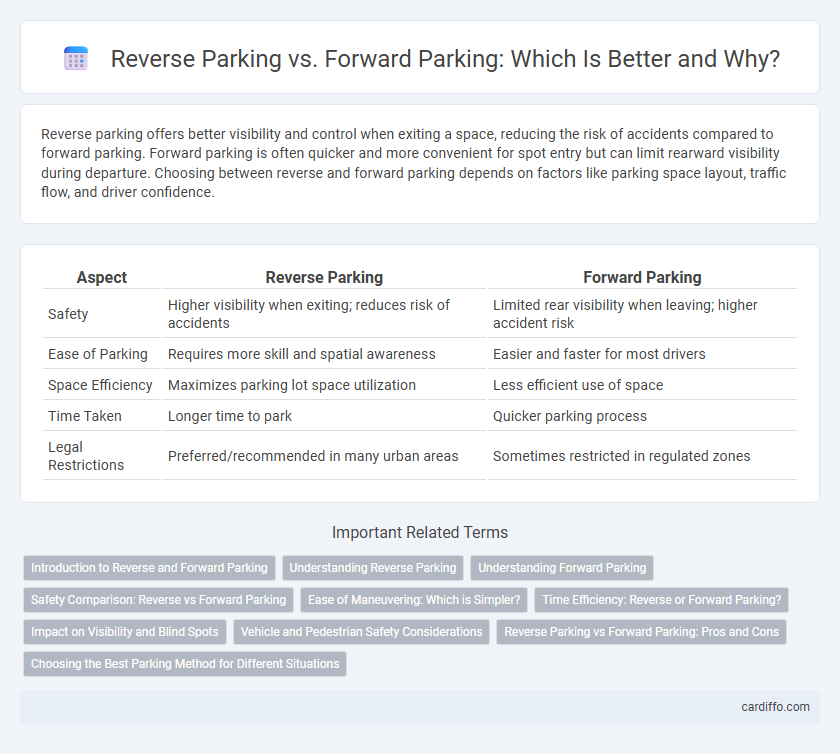Reverse parking offers better visibility and control when exiting a space, reducing the risk of accidents compared to forward parking. Forward parking is often quicker and more convenient for spot entry but can limit rearward visibility during departure. Choosing between reverse and forward parking depends on factors like parking space layout, traffic flow, and driver confidence.
Table of Comparison
| Aspect | Reverse Parking | Forward Parking |
|---|---|---|
| Safety | Higher visibility when exiting; reduces risk of accidents | Limited rear visibility when leaving; higher accident risk |
| Ease of Parking | Requires more skill and spatial awareness | Easier and faster for most drivers |
| Space Efficiency | Maximizes parking lot space utilization | Less efficient use of space |
| Time Taken | Longer time to park | Quicker parking process |
| Legal Restrictions | Preferred/recommended in many urban areas | Sometimes restricted in regulated zones |
Introduction to Reverse and Forward Parking
Reverse parking involves maneuvering a vehicle backward into a parking space, enhancing visibility of the parking spot and allowing easier exit. Forward parking requires driving straight into a space, which can be faster but may limit the driver's view of surroundings. Both techniques demand spatial awareness and skill to ensure safety and efficient use of parking areas.
Understanding Reverse Parking
Reverse parking enhances safety by providing better driver visibility and easier access to the vehicle's trunk. It reduces the risk of collisions when exiting a parking spot, especially in busy lots or on narrow streets. Mastering reverse parking requires practice with steering control and spatial awareness to align the vehicle accurately within parking lines.
Understanding Forward Parking
Forward parking offers increased visibility when entering and exiting spaces, reducing the risk of collisions with pedestrians and other vehicles. This method is especially advantageous in busy parking lots where quick access and smooth flow of traffic are essential. Drivers benefit from easier maneuvering and enhanced safety, making forward parking a preferred choice in many urban environments.
Safety Comparison: Reverse vs Forward Parking
Reverse parking offers enhanced safety by improving driver visibility of pedestrians and obstacles when exiting a space, reducing the risk of accidents. Forward parking can limit rearward visibility, increasing potential hazards during departure, especially in crowded or tight parking areas. Studies show that reverse parking lowers collision rates, making it a safer choice in environments with heavy pedestrian traffic.
Ease of Maneuvering: Which is Simpler?
Reverse parking often provides greater ease of maneuvering due to improved visibility of parking lines and surrounding obstacles from the driver's perspective. Forward parking typically requires less spatial awareness during the initial approach but can be more challenging to exit, especially in tight spots. Most drivers find reverse parking simpler for precision positioning and reduced risk of vehicle damage in confined areas.
Time Efficiency: Reverse or Forward Parking?
Reverse parking is often more time-efficient in tight spaces because it allows for better control and fewer adjustments when aligning with the parking spot. Forward parking can be quicker in open areas due to straightforward entry but may require more time for exiting as reversing out demands extra caution. Studies show reverse parking enhances overall maneuverability, reducing time spent correcting positioning in complex parking environments.
Impact on Visibility and Blind Spots
Reverse parking significantly improves driver visibility by allowing a clear view of oncoming traffic and pedestrians through the rearview mirror during exit, reducing blind spots compared to forward parking. Forward parking often limits visibility due to the rear of the vehicle obstructing the driver's view when leaving the space, increasing the risk of collisions with unseen obstacles. Studies show reverse parking decreases accidents in crowded areas by enhancing spatial awareness and minimizing blind spot-related incidents.
Vehicle and Pedestrian Safety Considerations
Reverse parking enhances vehicle and pedestrian safety by improving driver visibility and reducing blind spots during departure, minimizing collision risks. Forward parking can pose greater hazards when exiting, as drivers have limited view of oncoming pedestrians and traffic. Prioritizing reverse parking in busy areas significantly decreases accidents involving pedestrians and vehicles.
Reverse Parking vs Forward Parking: Pros and Cons
Reverse parking offers enhanced safety by allowing drivers to have a clearer view of oncoming traffic when exiting, reducing the risk of collisions. Forward parking is generally faster and simpler for less experienced drivers but can limit visibility and increase the risk of accidents when leaving the space. Reverse parking requires more skill and time but provides better control and safety advantages in crowded or tight parking environments.
Choosing the Best Parking Method for Different Situations
Reverse parking offers greater control and safety when entering tight spaces or busy lots, allowing drivers to exit with better visibility. Forward parking is faster and more convenient in open, spacious areas with minimal traffic. Selecting the best parking method depends on space constraints, traffic conditions, and driver comfort with maneuvering.
Reverse Parking vs Forward Parking Infographic

 cardiffo.com
cardiffo.com